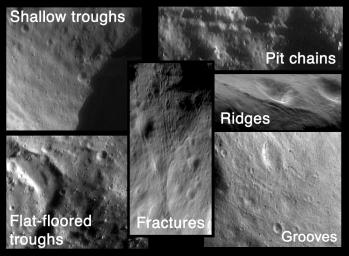
|
The Many Faces of Eros
- Click the image above for a larger view
- Full-Res JPEG (946 x 694) (96.4 kB)
- Full-Res TIFF (946 x 694) (578.5 kB)
Caption:
This montage shows structural features on Eros obtained by NEAR Shoemaker from several different orbits. Any underlying, deep-seated structures probably formed as a result of large impacts to the asteroid's surface, in the same way that a car windshield fractures when it is hit by a stone. Later, movement of regolith may have modified the structure's surface expressions.
Troughs -- Shallow troughs (top left) are found within the saddle region of Eros and are very closely aligned. A large flat-floored trough (bottom left) is found in the saddle.
Pits -- The top right image shows a chain of pits, most likely the result of loose regolith (impact-derived soil) draining into a crack on the asteroid's surface.
Ridges -- At center, right is the ridge that winds from Eros' saddle area around the north pole down to the 5.3-km crater.
Fractures -- The center image shows the region where the ridge ends. The ridge comes up from the bottom of the image and, near the center, appears to turn into a set of small fractures.
Grooves -- The bottom, right image shows grooves on a relatively smooth area of Eros' western hemisphere. These are evenly spaced and some look like they have raised rims.
Background Info:
Built and managed by The Johns Hopkins University Applied Physics Laboratory, Laurel, Maryland, NEAR was the first spacecraft launched in NASA's Discovery Program of low-cost, small-scale planetary missions. See the NEAR web page at http://near.jhuapl.edu/ for more details.
Cataloging Keywords:
| Name | Value | Additional Values |
|---|---|---|
| Target | 433 Eros | |
| System | Near Earth Objects | |
| Target Type | Asteroid | |
| Mission | NEAR Shoemaker | |
| Instrument Host | NEAR Shoemaker | |
| Host Type | Orbiter | |
| Instrument | Multi-Spectral Imager (MSI) | |
| Detector | ||
| Extra Keywords | Crater, Grayscale, Impact | |
| Acquisition Date | ||
| Release Date | 2001-02-17 | |
| Date in Caption | ||
| Image Credit | NASA/JPL/JHUAPL | |
| Source | photojournal.jpl.nasa.gov/catalog/PIA03108 | |
| Identifier | PIA03108 | |
